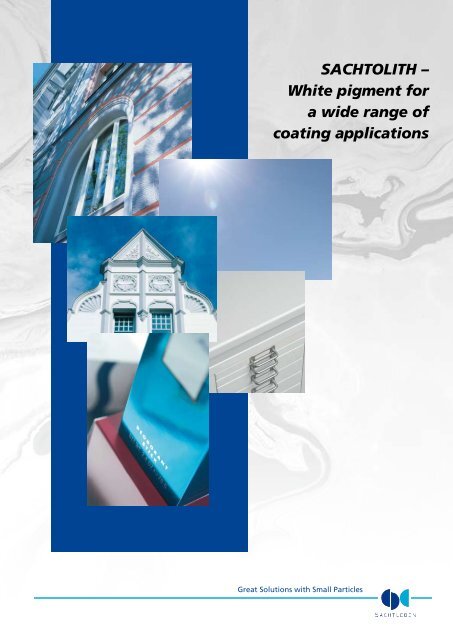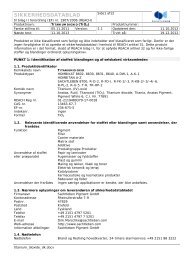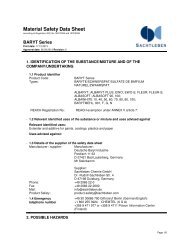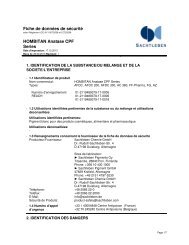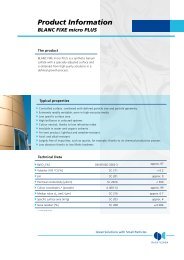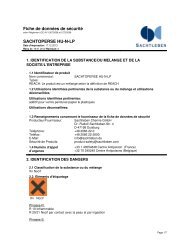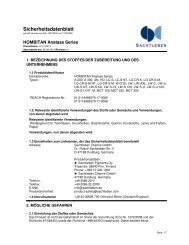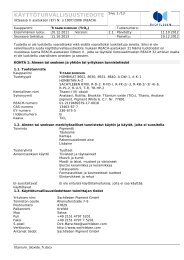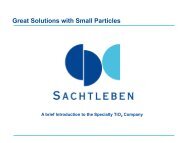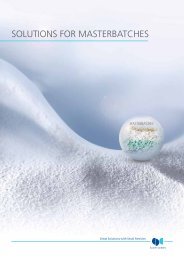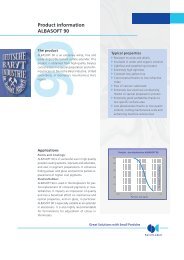SACHTOLITH – White pigment for a wide range of coating applications
SACHTOLITH – White pigment for a wide range of coating applications
SACHTOLITH – White pigment for a wide range of coating applications
You also want an ePaper? Increase the reach of your titles
YUMPU automatically turns print PDFs into web optimized ePapers that Google loves.
<strong>SACHTOLITH</strong> <strong>–</strong><strong>White</strong> <strong>pigment</strong> <strong>for</strong>a <strong>wide</strong> <strong>range</strong> <strong>of</strong><strong>coating</strong> <strong>applications</strong>Great Solutions with Small Particles
Great Solutions with Small Particles1<strong>SACHTOLITH</strong> <strong>–</strong> the white <strong>pigment</strong>based on pure Zinksulfide. Designedto <strong>of</strong>fer solutions <strong>for</strong> a <strong>wide</strong> <strong>range</strong> <strong>of</strong><strong>applications</strong>.Because <strong>of</strong> its special properties likeMoh’s hardness, UV-absorption edgeand low specific surface area. Theseparticles provide benefits to many <strong>applications</strong>.
<strong>SACHTOLITH</strong>The product<strong>SACHTOLITH</strong> (CAS Registration No. 1314-98-3)is a white <strong>pigment</strong> consisting <strong>of</strong> extremely purezinc sulfide. Highly purified zinc salt and sodiumsulfide solutions, from which all discolorant andtoxic heavy metals have been removed down toppm trace levels, are used <strong>for</strong> its production.The extremely finely precipitated zinc sulfide isadjusted to the narrow particle-size distribution<strong>of</strong> approx. 0.3 μm which is optimum <strong>for</strong> scatter-ing <strong>of</strong> light by means <strong>of</strong> calcining at around700° C. Three <strong>SACHTOLITH</strong> grades are produced:L, HD and HD-S.The <strong>SACHTOLITH</strong> grades<strong>SACHTOLITH</strong> L is the standard grade, with noorganic treatment. <strong>SACHTOLITH</strong> HD and HD-Scontain small amounts <strong>of</strong> organic wetting agentsto improve wettability and dispersibility in aqueousand organic media. Thanks to its high-energygrinding process (micronization) and a specialscreening process, <strong>SACHTOLITH</strong> HD-S is free <strong>of</strong>coarse particles and is easily dispersed. Its opticalper<strong>for</strong>mance is some 10 to 15 % superior to that<strong>of</strong> the L and HD grades.2
Properties <strong>of</strong> <strong>SACHTOLITH</strong>ChemicalIn the >4 pH <strong>range</strong>, <strong>SACHTOLITH</strong> is resistant topractically all chemicals. Its solubility in 0.1 mhydrochloric acid is approx. 0.3 %.<strong>SACHTOLITH</strong> can be oxidized to ZnSO 4by powerfuloxidizing agents or by UV radiation in thepresence <strong>of</strong> water and oxygen. ZnS is capable <strong>of</strong>reacting superficially with additives which containheavy metals, particularly at high processing temperaturesand under exposure to UV radiation.The property <strong>of</strong> fixing undesirable heavy-metalions can, on the other hand, prevent catalyticcracking <strong>of</strong> polymers. Unlike TiO 2, ZnS does notgenerate any colored complexes with phenolicanti-oxidants, and reduces the catalytic oxidation<strong>of</strong> polymers. <strong>SACHTOLITH</strong> also remains stable upto at least 350° C under exposure to air oxygen.Physical<strong>SACHTOLITH</strong> consists primarily <strong>of</strong> polycrystallinewurtzite and is an n-type photo semiconductor,like the TiO 2<strong>pigment</strong>s. Under normal conditions,<strong>SACHTOLITH</strong> is a good isolator (e relapprox. 8). Atapprox. 27 W m -1 K -1 , its thermal conductivity isunusually high <strong>for</strong> a mineral product, its specificheat, on the other hand, extremely low, at some500 J kg -1 K -1 .Specific surface area and binder requirement arelow and permit good rheological properties evenat high <strong>pigment</strong>ation levels. In combination withthe <strong>pigment</strong>‘s low UV absorption, its good lightreflectance in the visible <strong>range</strong> produces a neutralwhite tone and results in optimum effectiveness<strong>of</strong> optical brighteners, Day-Glow paints andphotoinitiators.Due to the product‘s lower refractive index (2.37)compared to TiO 2, its scattering power is lowerthan that <strong>of</strong> rutile by 35 % and than that <strong>of</strong> anataseby 25 %. Its spherical particle geometry andlow Mohs hardness <strong>of</strong> 3 mean that <strong>SACHTOLITH</strong>causes no abrasion or wear on metallic materials.Toxicological<strong>SACHTOLITH</strong> is a practically insoluble inorganicsubstance containing no harmful or notifiableconstituents. Under correct use, it is non-toxicand is suitable, inter alia, <strong>for</strong> the <strong>pigment</strong>ation<strong>of</strong> toys and foodstuffs packaging materials.<strong>SACHTOLITH</strong> is registered and approved <strong>for</strong>use in a large <strong>range</strong> <strong>of</strong> countries; the followingare intended only as examples:Germany:BfR: Meets limitsVwVwS:Not a water pollutantEU:AP 89 (1) and AP 96 (5) Ref. No. 96320EN 71/3Hazardous Substances Ordinance:Not a hazardous in EEC 67/548 ff.Japan:MITI 1-572USA:FDA § 178.3297TSCA 1314-98-3Clean Air Act Amendments: Not listedHazardous Air Pollutants: Not an air pollutant3
Technical Data <strong>of</strong> <strong>SACHTOLITH</strong><strong>SACHTOLITH</strong> L HD HD-SZnS [%] approx. 98 98 98Volatile constituents (105° C) [%] DIN EN ISO 787-2 approx. 0.2 0.2 0.2pH DIN EN ISO 787-9 approx. 6 7 7Sieve residue [%] 1 DIN 53 195 < 0.02 < 0.02 < 0.004Hardness (Mohs) approx. 3 3 3Relative scattering power 3 DIN 53 165 > 50 > 50 > 52Lightness L* ISO 7724 approx. 98 98 98Refractive index 2.37 2.37 2.37Dispersibility satisfactory good very goodLight fastness good good goodWeathering resistance satisfactory* satisfactory* satisfactory*1) Mesh gauge 45 μm 2) Measured by means <strong>of</strong> sedimentation 3) Reference <strong>pigment</strong>: Standard TiO 2= 100* in combination with TiO 2good weathering resistance possibleNotes <strong>for</strong> processing<strong>SACHTOLITH</strong> HD-S can be dispersed in the Cow-les dissolver to grindometer finenesses <strong>of</strong> lessthan 20 µm at high speeds within 15 to20 minutes; additional dispersion on the roll millor in a pearl mill is recommendable in the case <strong>of</strong><strong>SACHTOLITH</strong> L and <strong>SACHTOLITH</strong> HD.Health and Safety<strong>SACHTOLITH</strong> is practically free <strong>of</strong> toxic heavymetals and there<strong>for</strong>e fulfills the recommendations<strong>of</strong> the German BfR Recommendation IX<strong>for</strong> <strong>pigment</strong>s, as well as a large <strong>range</strong> <strong>of</strong> othernational purity specifications.4
Applications <strong>of</strong> <strong>SACHTOLITH</strong>GeneralIts low binder requirement combined with itsgood rheological and white-<strong>pigment</strong> propertiesenable <strong>SACHTOLITH</strong> to be used costeffectivelyand with technical benefits whereverorganic and inorganic binders need tobe highly <strong>pigment</strong>ed <strong>for</strong> specific <strong>applications</strong>,such as in undercoat lacquers, jointing andsealing compounds, primers, etc. and also inputties, mastics and marking paints.Emulsion paints and dispersionplastersCombined with titanium dioxide-<strong>pigment</strong>edemulsion paints and dispersion plasters,<strong>SACHTOLITH</strong> can improve rheological per<strong>for</strong>manceand thus provide better conditions <strong>for</strong> application.Combination with UV-absorbing <strong>pigment</strong>s,such as TiO 2or iron oxide <strong>pigment</strong>s is the precondition<strong>for</strong> the use <strong>of</strong> <strong>SACHTOLITH</strong> in weatheringresistantpaint and <strong>coating</strong> systems.In many cases <strong>SACHTOLITH</strong> used in emulsionpaints and dispersion plasters shows a positivecontribution to keep surfaces white over a longperiod <strong>of</strong> time.<strong>SACHTOLITH</strong> has proven to be stable againstflocculation and to <strong>of</strong>fer favorable flow per<strong>for</strong>mancein a large number <strong>of</strong> paint and <strong>coating</strong>systems. <strong>SACHTOLITH</strong> also exhibits a remarkablystabilizing effect when combined with colored<strong>pigment</strong>s, producing positive effects in the <strong>for</strong>m<strong>of</strong> only slight flotation and flooding.5
Printing inksThe color neutrality achievable with <strong>SACHTOLITH</strong>is highly esteemed in printing inks. The <strong>pigment</strong>‘slow abrasiveness reduces wear on the dies andmatrices used <strong>for</strong> printing and increases life time<strong>of</strong> the doctor blade.UV cured paint systemsThe photoinitiators used <strong>for</strong> the curing <strong>of</strong> pig-mented UV paint systems generally absorb lightin the wavelength <strong>range</strong> in which covering white<strong>pigment</strong>s, and titanium dioxide in particular, alsoabsorb light to such an extent that adequatecross-linking cannot occur. <strong>SACHTOLITH</strong>, a zincsulfide <strong>pigment</strong>, the absorption edge <strong>of</strong> which issignificantly shifted into the short-wave <strong>range</strong>,is an exception. Sufficient UV radiation <strong>for</strong> theachievement <strong>of</strong> photoinitiator action and <strong>for</strong>complete curing thus remains available:The curing <strong>of</strong> white UV-<strong>coating</strong>s <strong>pigment</strong>ed with<strong>SACHTOLITH</strong> is easier, faster and complete <strong>–</strong> evenat higher film thickness.This leads to lower energy consumption duringUV-Curing and better results concerning mechan-ics and adhesion <strong>of</strong> the film. On the other handeconomics increase as <strong>SACHTOLITH</strong> replaces acertain resin share without increased resin de-mand and the content <strong>of</strong> photo initiator can bereduced by up to 20%.System:<strong>SACHTOLITH</strong> and TiO 2-Rutil: absorptionLaromer PE 44 FLaromer PO 83 F (PE Acrylates)<strong>SACHTOLITH</strong>TiO 2-RutilePowder <strong>coating</strong> systems<strong>SACHTOLITH</strong> can also be used to advantage in<strong>SACHTOLITH</strong> can also be used to advantage inpowder-<strong>coating</strong> systems, since complete UVpowder-<strong>coating</strong>systems, since complete UVcuringis especially a problem when applying highcuring is especially a problem when applying highfilm thicknesses. Additionally <strong>SACHTOLITH</strong> canfilm thicknesses. Additionally <strong>SACHTOLITH</strong> canimprove rheological properties in powder <strong>coating</strong>sand enhances flow and throughput. The <strong>pigment</strong>‘scolor neutrality permits its use in all tints.ZnSExample <strong>of</strong> ZnS inUV curing systemsTiO 2-Rutile6
04.009.03.09.e Sachtleben übernimmt keinerlei Gewähr für Genauigkeit, Aktualität, Korrektheit, Vollständigkeit, Qualität oder Brauchbarkeit der bereitgestellten In<strong>for</strong>mationen.Jegliche Haftungsansprüche im Zusammenhang mit diesen In<strong>for</strong>mationen sind ausgeschlossen.Great Solutions with Small ParticlesSachtleben Chemie GmbHA company <strong>of</strong>Holdings, Inc.P.O. Box 17 04 54 • D-47184 Duisburg / GermanyPhone +49 2066 22-2615 • Fax +49 2066 22-3615E-Mail: <strong>coating</strong>s@sachtleben.com • www.sachtleben.com


